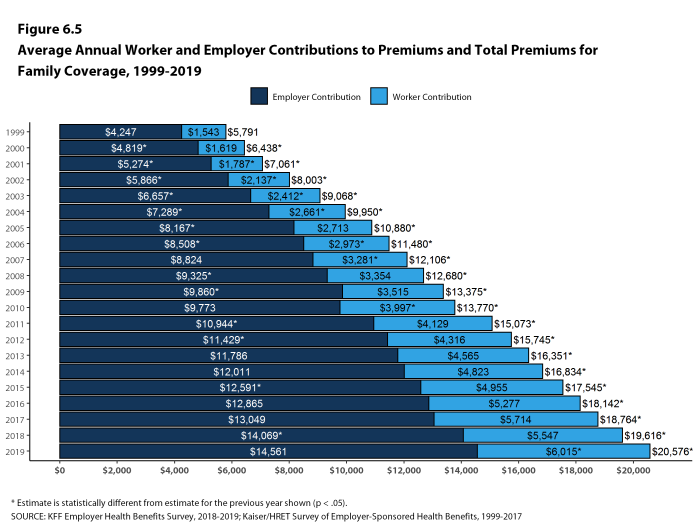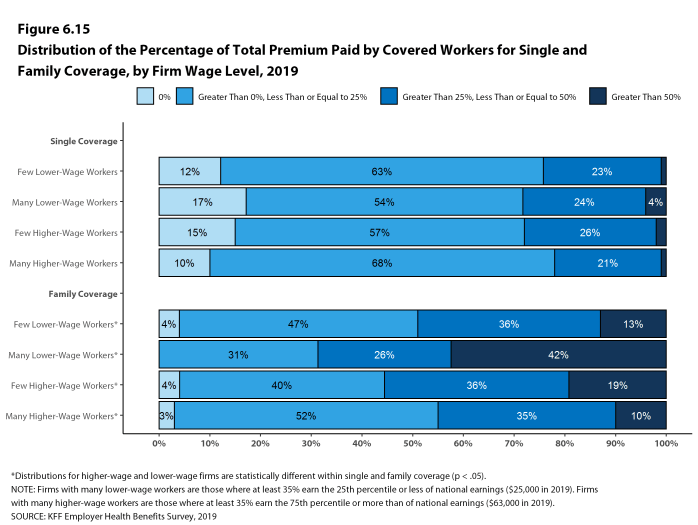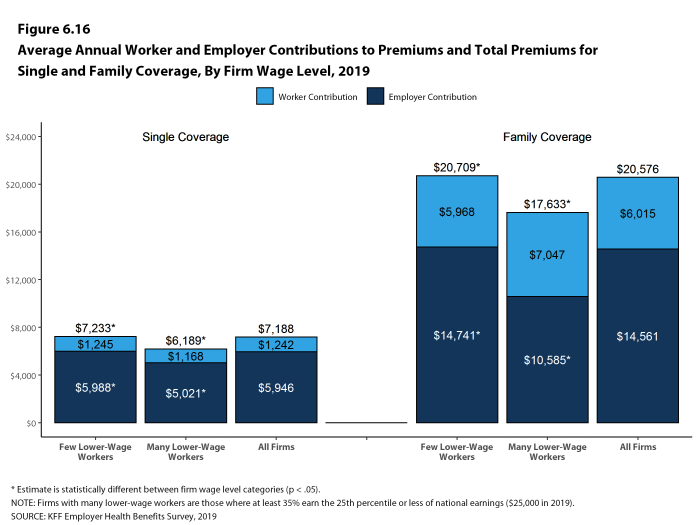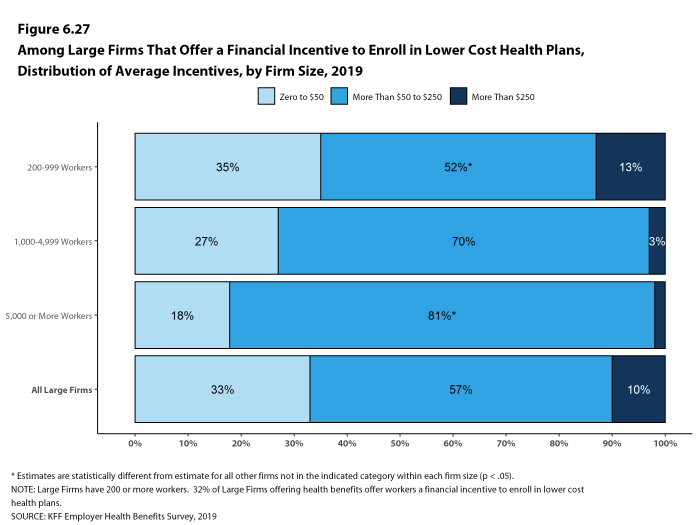Section 6: Worker and Employer Contributions for Premiums
In 2019, premium contributions by covered workers average 18% for single coverage and 30% for family coverage.16 The average monthly worker contributions are $103 for single coverage ($1,242 annually) and $501 for family coverage ($6,015 annually). Compared to covered workers in large firms (200 or more workers), covered workers in small firms (3-199 workers) have a lower contribution, on average, for single coverage ($1,035 vs. $1,330) but a
higher average contribution for family coverage ($7,805 vs. $5,271).
- In 2019, covered workers on average contribute 18% of the premium for single coverage and 30% of the premium for family coverage [Figure 6.1].17 The average percentage contributed for single coverage has remained stable in recent years. While estimates of the average contribution percentage for family coverage have shown small changes in recent years, the differences are not statistically significant.
- Covered workers in small firms on average contribute a much higher percentage of the premium for family coverage (40% vs. 26%) than covered workers in large firms [Figure 6.2].
- Workers with single coverage have an average contribution of $103 per month ($1,242 annually), and workers with family coverage have an average contribution of $501 per month ($6,015 annually) toward their health insurance premiums [Figure 6.3], [Figure 6.4], and [Figure 6.5].
- The average worker contributions in HDHP/SOs are lower than the overall average worker contribution for single coverage ($1,071 vs. $1,242) and family coverage ($4,866 vs. $6,015). The average worker contributions in PPOs are higher than the overall average worker contribution for single coverage ($1,454 vs. $1,242) [Figure 6.6].
- Worker contributions also differ by firm size.
- Covered workers in small firms on average contribute less for single coverage than covered workers in large firms ($1,035 vs. $1,330) [Figure 6.7].
- Covered workers in small firms on average contribute significantly more annually for family coverage ($7,805 vs. $5,271) [Figure 6.7].
- Covered workers working for private, not for profit firms have a relatively low average contribution for single coverage ($1,057) while covered workers working for private for profits firms have a relatively high average contribution for single coverage ($1,341).
Figure 6.1: Average Percentage of Premium Paid by Covered Workers for Single and Family Coverage, 1999-2019
Figure 6.2: Average Percentage of Premium Paid by Covered Workers for Single and Family Coverage, by Firm Size, 2019
Figure 6.4: Average Annual Worker and Employer Contributions to Premiums and Total Premiums for Single Coverage, 1999-2019
Figure 6.5: Average Annual Worker and Employer Contributions to Premiums and Total Premiums for Family Coverage, 1999-2019
Figure 6.6: Average Annual Worker and Employer Premium Contributions and Total Premiums for Single and Family Coverage, by Plan Type, 2019
Figure 6.7: Average Annual Worker and Employer Premium Contributions and Total Premiums for Single and Family Coverage, by Firm Size, 2019
Figure 6.8: Average Annual Worker and Employer Premium Contributions and Total Premiums for Single Coverage, by Plan Type and Firm Size, 2019
Figure 6.9: Average Annual Employer and Worker Premium Contributions and Total Premiums for Family Coverage, by Plan Type and Firm Size, 2019
DISTRIBUTIONS OF WORKER CONTRIBUTIONS TO THE PREMIUM
- About nine-tenths of covered workers are in a plan where the employer contributes at least half of the premium for both single and family coverage.
- Thirteen percent of covered workers are in a plan where the employer pays the entire premium for single coverage, while only 4% of covered workers are in a plan where the employer pays the entire premium for family coverage [Figure 6.10].
- Covered workers in small firms are much more likely than covered workers in large firms to be in a plan where the employer pays the entire premium.
- Thirty-one percent of covered workers in small firms have an employer that pays the full premium for single coverage, compared to 5% of covered workers in large firms [Figure 6.10].
- For family coverage, 10% of covered workers in small firms have an employer that pays the full premium, compared to 1% of covered workers in large firms [Figure 6.10].
- Fifteen percent of covered workers are in a plan with a worker contribution of more than half of the premium for family coverage [Figure 6.10].
- Thirty-five percent of covered workers in small firms work in a firm where the worker contribution for family coverage is more than 50% of the premium, a much higher percentage than the 6% of covered workers in large firms [Figure 6.10].
- Small shares of covered workers in small firms (3%) and large firms (1%) must pay more than 50% of the premium for single coverage [Figure 6.10].
- There is substantial variation among workers in both small and large firms in the dollar amounts they must contribute.
- Among covered workers in small firms, 43% have a contribution for single coverage of less than $500, while 18% have a contribution of $2,000 or more. For family coverage, 13% have a contribution of less than $1,500, while 29% have a contribution of $10,500 or more [Figure 6.13] and [Figure 6.14].
- Among covered workers in large firms, 16% have a contribution for single coverage of less than $500, while 16% have a contribution of $2,000 or more. For family coverage, 5% have a contribution of less than $1,500, while only 4% have a contribution of $10,500 or more [Figure 6.13] and [Figure 6.14].
Figure 6.10: Distribution of Percentage of Premium Paid by Covered Workers for Single and Family Coverage, by Firm Size, 2019
Figure 6.11: Distribution of Percentage of Premium Paid by Covered Workers for Single Coverage, 2002-2019
Figure 6.12: Distribution of Percentage of Premium Paid by Covered Workers for Family Coverage, 2002-2019
DIFFERENCES BY FIRM CHARACTERISTICS
- The percentage of the premium paid by covered workers also varies by firm characteristics.
- Covered workers in private for-profit firms on average have higher contribution rates for both single coverage (20%) and family coverage (32%) than workers in other types of firms. Covered workers in private not for profit organizations have lower contribution rates for single coverage (14%) than workers in other types of firms [Figure 6.19].
- Covered workers in firms with a relatively large share of lower-wage workers (where at least 35% of workers earn $25,000 a year or less) have a higher average contribution rate for family coverage (41% vs. 30%) than those in firms with a smaller share of lower-wage workers [Figure 6.17].
- Covered workers in firms with a relatively large share of higher-wage workers (where at least 35% earn $63,000 or more annually) have a lower average contribution rate for family coverage than those in firms with a smaller share of higher-wage workers (28% vs. 33%) [Figure 6.17].
- Covered workers in firms that have at least some union workers have a lower average contribution rate for family coverage than those in firms without any union workers (24% vs. 33%) [Figure 6.17].
- Covered workers in firms that are partially or completely self-funded on average have a lower average contribution rate for family coverage than workers in firms that are fully-insured (26% vs. 37%) [Figure 6.17].18
Figure 6.15: Distribution of the Percentage of Total Premium Paid by Covered Workers for Single and Family Coverage, by Firm Wage Level, 2019
Figure 6.16: Average Annual Worker and Employer Contributions to Premiums and Total Premiums for Single and Family Coverage, by Firm Wage Level, 2019
Figure 6.17: Average Annual Premium Contributions Paid by Covered Workers for Single and Family Coverage, by Firm Characteristics, 2019
Figure 6.18: Average Percentage of Family Premium Paid by Covered Workers, by Firm Characteristics, 2019
DIFFERENCES BY REGION AND INDUSTRY
- The average worker contribution rate for single coverage is lower in the West (13%) and higher in the Midwest (21%) than in other regions [Figure 6.20].
- The average worker contribution rate for family coverage is higher in the South (34%) than in other regions [Figure 6.20].
Figure 6.20: Average Premium Paid by Covered Workers for Single and Family Coverage, by Plan Type and Region, 2019
CHANGES OVER TIME
- The average worker contributions for single coverage ($1,242 in 2019) is similar to last year. The average worker contribution for family coverage ($6,015 in 2019) is higher than the average contribution for family coverage last year ($5,547) [Figure 6.23] and [Figure 6.24].
- The average worker contributions for single and family coverage have increased over the last five years (15% and 25%, respectively) and over the last 10 years (59% and 71%, respectively).
- Over the past ten years, the average worker contribution for family coverage has increased faster than the average employer contribution for family coverage (71% vs. 48%).
Figure 6.22: Average Annual Worker Contributions for Covered Workers With Single Coverage, by Firm Size, 1999-2019
Figure 6.23: Average Annual Worker Contributions for Covered Workers With Family Coverage, by Firm Size, 1999-2019
Figure 6.24: Average Percentage of Premium Paid by Covered Workers for Single and Family Coverage, by Firm Size, 1999-2019
FINANCIAL INCENTIVES
- Thirty-two percent of large firms provide a financial incentive to choose a lower cost health plan.
- Large employers with a financial incentive for employees to choose a lower cost plan option report that, on average, employees can save $104 monthly if they choose the lowest cost single plan available to them.
Figure 6.26: Among Large Firms Offering Health Benefits, Percentage That Offer Financial Incentive to Enroll in Lower Cost Health Plans, by Firm Size, 2019
- Estimates for premiums, worker contributions to premiums, and employer contributions to premiums presented in Section 6 do not include contributions made by the employer to Health Savings Accounts (HSAs) or Health Reimbursement Arrangements (HRAs). See Section 8 for estimates of employer contributions to HSAs and HRAs.↩
- The average percentage contribution is calculated as a weighted average of all a firm’s plan types and may not necessarily equal the average worker contribution divided by the average premium.↩
- For definitions of self-funded and fully-insured plans, see the introduction to Section 10.↩
Sections
- Section 1: Cost of Health Insurance
- Section 2: Health Benefits Offer Rates
- Section 3: Employee Coverage, Eligibility, and Participation
- Section 4: Types of Plans Offered
- Section 5: Market Shares of Health Plans
- Section 6: Worker and Employer Contributions for Premiums
- Section 7: Employee Cost Sharing
- Section 8: High-Deductible Health Plans with Savings Option
- Section 9: Prescription Drug Benefits
- Section 10: Plan Funding
- Section 11: Retiree Health Benefits
- Section 12: Health and Wellness Programs
- Section 13: Grandfathered Health Plans
- Section 14: Employer Practices and Health Plan Networks



























